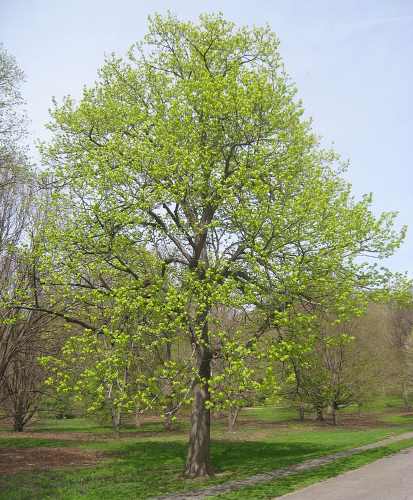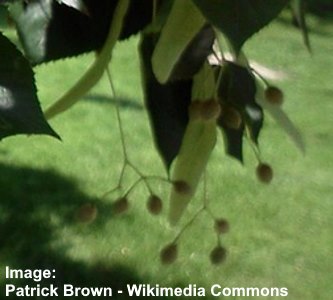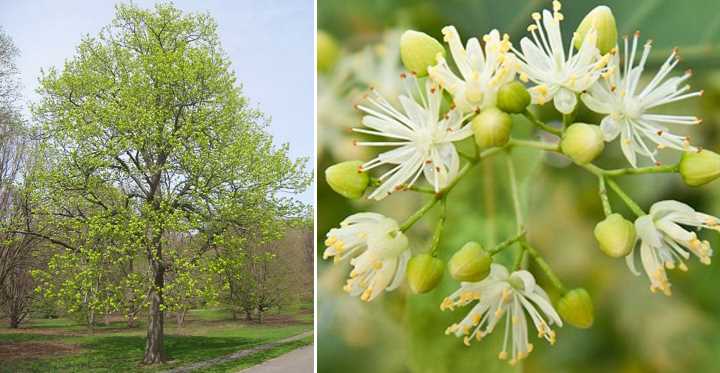With fragrant yellowish-white flowers, big ovate leaves, and a domed crown, the American basswood tree (Tilia americana) is a huge fast-growing deciduous flowering tree. The American basswood tree, sometimes known as the American linden, is a popular ornamental shade tree with deep foliage and spreading canopy.
Additionally, because of the high honey bees produced from the flowers’ nectar, basswood trees are popular with beekeepers.
The genus Tilia contains just one native North American species, the American basswood tree. Linden trees are the other tree species in the genus Tilia. Linden trees are known as lime trees in Europe. Common linden (Tilia x europaea), silver linden (Tilia tomentosa), and little-leaf linden (Tilia cordata) are three of the most popular types of linden trees.
The natural American basswood tree is the subject of this complete article. This magnificent shade tree may be identified by descriptions and photographs of American linden trees.
What is American Basswood (American Linden) Tree?

In the Tilia genus of flowering trees, American basswood is the only native species. One of the fastest-growing hardwood trees in the United States is the American linden. Eastern and central North America are home to American basswood, which grows for approximately 200 years.
Basswood Tree Leaves

The serrated edges and pointed tip of basswood tree leaves distinguish them from other types of leaves. The basswood leaves have a lopsided base, which is an indication of their asymmetrical structure. The leaves are up to 6” (15 cm) broad and 4” to 8” (10 – 20 cm) long. Compared to European linden types, American basswood leaves are bigger.
On branches, the ovate, serrated basswood leaves are arranged alternately. The topside of the leaves is dark green during the growing season, while the underside is light pale-green. The leaves of deciduous basswood trees turn yellowish-green in the autumn.
Basswood Tree Flowers

One of the tree’s most notable features is its green narrow leaf-like bracts, which bloom above basswood flowers. Basswood trees produce small, nectar-rich, fragrant yellowish-white flowers that hang from the tree on a bract-shaped cluster. Each bunch of basswood tree blooms contains 6 to 20 blossoms, each of which is 0.4 inches (1 cm) in diameter.
The distinctive identifying characteristic of American basswood trees is the long, pale, green leaf-like bracts that rise over the flower clusters. In early summer, American basswood blooms and may stay until autumn. The blooms turn into basswood fruit after blooming. On the ends of the dried long, tongue-shaped bracts, small, globular green nutlets cluster.

Honeybees are drawn to close-up photos of basswood fruit (nutlets). High-quality honey is produced from the nectar of the tree’s flowers. Because of the sweet perfume and excellent honey bees, basswood trees are often planted by beekeepers.
Basswood Tree Bark

American basswood bark is gray to gray-brown, and it can be almost black in appearance. Young basswood bark has fine ridges and appears smooth and gray. Basswood bark becomes darker and fissured as the tree grows, developing a rough, scaly appearance. On basswood trees, you can see deep, vertically oriented furrows.
Basswood Tree Fruit
Little spherical nuts, up to 0.4″ (1 cm) in diameter, make up the American basswood fruit. The fuzzy coating of the little rounded nuts grows in open clusters. Basswood nuts range in color from white to green on various trees. The tongue-like bracts that hang from basswood fruit clusters are an identifying characteristic.
Basswood Tree Identification

By their clusters of creamy or yellowish fragrant flowers linked to long leaf-like bracts, American basswood trees may be identified. Basswoods have heart-shaped, asymmetrical leaves with coarsely serrated borders and sharp tips, which is a characteristic of the species.
Basswood trees’ silvery-gray bark on young specimens that becomes furrowed, rough, and dark gray is another identifying characteristic. Basswood trees have an oval to oblong crown with thick foliage and wide ovate leaves that may be seen in landscapes.
Basswood Tree Uses
Due to its workability, American basswood is used for a variety of purposes. Basswood is a cost-effective kind of wood for making furniture, boxes, and cabinets because it is quite soft and easy to split. Carving is also made out of American linden wood. Honey is also obtained from basswood trees. Honeybees are drawn to the flowers’ abundant nectar all summer. Honey is offered as basswood honey because it is so good.
How to Care for Basswood Tree (American Linden)
Grow the ornamental tree in full sun and wet, well-drained soil to care for an American basswood tree. The low-maintenance, little-to-no pruning American linden tree is stunning. To keep moisture in and weeds at bay, mulch the tree trunk. Only when the basswood tree is completely dry should you water it.
Types of Basswood Trees (Tilia americana)
The American basswood (Tilia americana) is the most common species of basswood. The species has a number of cultivars, each with its own distinct growing features.
American Basswood (Tilia americana)

The American basswood is a linden tree species and the mallow (hibiscus) family of trees that grows in the United States. The most frequent Tilia species in the United States is the American linden (basswood). It’s one of the most massive leaves among native species, a vast deciduous ornamental shade tree.
USDA zones 3–8 allow for the growth of stately American basswood trees. They can also be found in zone 2’s shaded habitats. The majestic tree, which grows between 50 and 80 feet (15 and 24 meters) tall and 30 to 50 feet (9 to 15 meters) broad, has a massive spreading rounded pyramidal crown.
You’ll need a lot of room to grow basswood trees in your yard since they’re so big. Shade trees, towering privacy hedges, and street trees are all popular uses for linden trees. Air pollution and urban conditions, on the other hand, are not suitable for ornamental landscape basswood trees.
Among the greatest hardwoods in eastern and central North America, American basswood is one of the largest. In the Great Lake states, the tree is a major source of timber. On the west and north coasts of the United States, lindens may be found growing as far east as Minnesota. Basswood trees may be found in parts of Tennessee and North Carolina to the south.
Among the broadleaf trees in the United States, American basswood leaves are among the biggest. With their rough, serrated edges, pointed tip, and prominent yellowish veins, the enormous heart-shaped leaves are easy to spot. Your hand is dwarfed by some of the bigger linden leaves. The appeal of basswood trees as shade trees is enhanced by this feature.
The abundant nectar and lovely fragrance of American basswood flowers attracts bees. When basswood trees are in bloom throughout the summer, it’s simple to see them. Long bracts hang clusters of fuzzy-looking globular flowers. Once the leaves have faded to yellow and dropped in the autumn, small basswood fruits emerge on the trees. Brown dried bracts suspend brown clusters of tiny roundish nuts.
Popular American Basswood Cultivars
Some of the most popular Tilia americana cultivars are listed below:
Carolina Basswood (Tilia americana var. caroliniana): This smaller American basswood species tree grows between 50 and 80 feet (15 and 24 meters) high. The ovate leaves are diamond-shaped rather than rounded and serrated. From North Carolina to Florida, carolina basswoods commonly grow on the southern east coast of the US.

Redmond Basswood (Tilia americana ‘Redmond’): The thick foliage and pyramidal form of this basswood cultivar are distinguishing features. This basswood can grow to be 35 feet (10 meters) tall.
White Basswood (Tilia americana var. heterophylla): Linden leaves have serrated edges and a whitish underside, giving the tree’s foliage a pale color. From Missouri to Alabama, you can see these linden trees.
Boulevard American Basswood (Tilia americana ‘Boulevard’): The linden tree grows up to 50 feet (15 meters) tall and is narrow. Due to its tightly curved development, you may notice this tree.
Lincoln Linden (Tilia americana ‘Lincoln’): The rounded, pyramidal form of this American basswood cultivar is accented by thick, dark green leaves. The linden tree can reach a height of 35 feet (10 meters) and a width of 25 feet (7.5 meters).
Legend American Basswood (Tilia americana ‘DTR 123’): Its robustly pyramidal development and glossy, dark green leaves distinguish this basswood. The cultivar’s winter buds and twigs are bright red.
American Basswood (Tilia americana) Care Guide
These huge shade trees are commonly used in big residential garden settings. Let’s take a closer look at how to treat these magnificent decorative trees.
Where to Plant American Basswood Tree
In a sunny portion of your yard, grow American basswood trees. Basswood trees flourish when they get six hours of sunlight every day. the trees, on the other hand, can tolerate some shade. Remember that a basswood tree is an imposing decorative tree when deciding on a location to plant one. American basswoods may reach a height of 80 feet (24 meters) and a width of 50 feet (15 meters).
Planting an American linden in the fall is the optimum time. In a hole that is lined up with the ground, plant the bare root tree. Organically rich soil and water well should be filled in the empty space. Water a freshly planted basswood every week or two for the first three months. The soil is also kept moisture locked in by mulching around the tree.
The Best Soil for Growing American Linden Trees
In neutral to alkaline soils, American basswood trees thrive best. They will, on the other hand, perform well in mildly acidic soil. The nitrogen-hungry tree should thrive in most landscapes as long as it receives enough moisture and sunlight.
How to Water American Basswood Trees
Drought tolerance is a characteristic of American linden trees. It’s critical to keep the soil moist but not saturated for the basswood tree to survive. Water the soil often during dry spells to keep it hydrated. You do not need to add more water at other times, however.
Add 4″ (10 cm) of mulch around the root zone to create the optimum environment for the linden tree. To avoid rot, leave a 2″ (5 cm) area around the tree free from mulch.
American Basswood Growth Rate
American basswood trees grow at a rapid pace, producing 2 feet (0.6 meters) each year. American basswood trees reach a height of 20 to 30 feet (6 to 9 meters) after 20 to 30 years. A 50 to 80 foot (15 to 24 m) tall mature basswood tree develops.
How to Fertilize American Basswood Tree
To thrive, American basswood trees need a lot of nitrogen in the soil. Add a layer of organic compost around the base of newly planted basswood trees. That should be fine. 1 to 2 inches (2.5 to 5 cm) Because it contains nitrogen, rotted manure is particularly beneficial for basswood trees.
Every two years, usually in April or May, fertilize a basswood tree with a spring application. You may not need to fertilize the tree if it has expanded at least 6 inches (15 cm) each year since its last growth. Slow-release fertilizers with an NPK rating of 18-6-12 are recommended if you decide to use them. Fertilize the basswood tree in a circle that is at least twice its height.
Pruning American Basswood Trees
In residential landscapes, American basswood trees benefit from pruning on a regular basis. Weak or dead branches from the linden tree should be removed every winter. Trimming branches that extend toward the crown’s center is also a good idea. In the summer, encourage new growth by pruning young, newly planted linden trees.
Remove branches that stretch towards the center of the crown or rub on other branches during the tree’s first four years. To avoid multiple stems from developing, it might be necessary to eliminate any suckers that develop on the ground.
Pests Affecting Basswood Tree Growth
The Japanese beetles that attack American linden trees are quite frequent. Linden looper caterpillars, basswood leaf miners, and fall webworms can all infest linden trees, however. These common leaf feeders are most often found attacking plants, making them appear unattractive.
Aphids may also bite little twigs and create a goopy honeydew substance that ants can detect. Linden trees may get black sooty mold if honeydew is a cause. Linden mites and scale insects are also to be aware of.
Diseases Affecting American Basswood Trees
Bacterial leaf blight and powdery mildew can both cause basswood leaves to wilt and fall from the tree sooner than they should. Black or brown spots on the leaves of a plant are signs of leaf blight. A white, flour-like substance on leaves might indicate the presence of powdery mildew.
